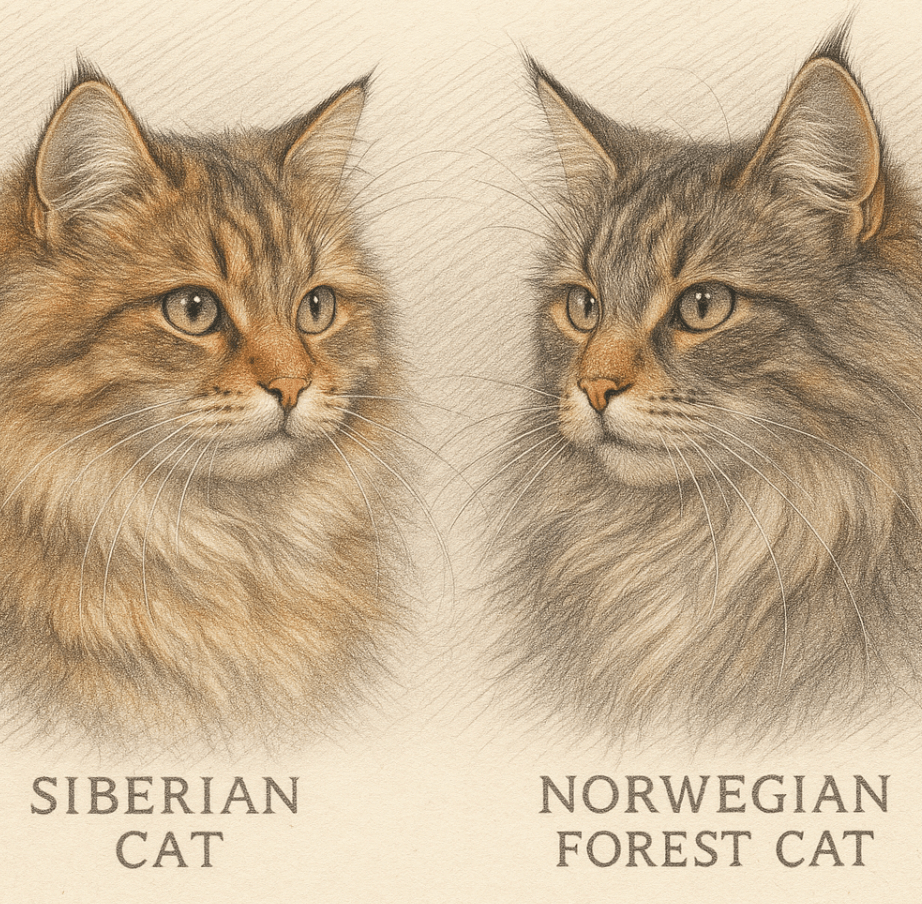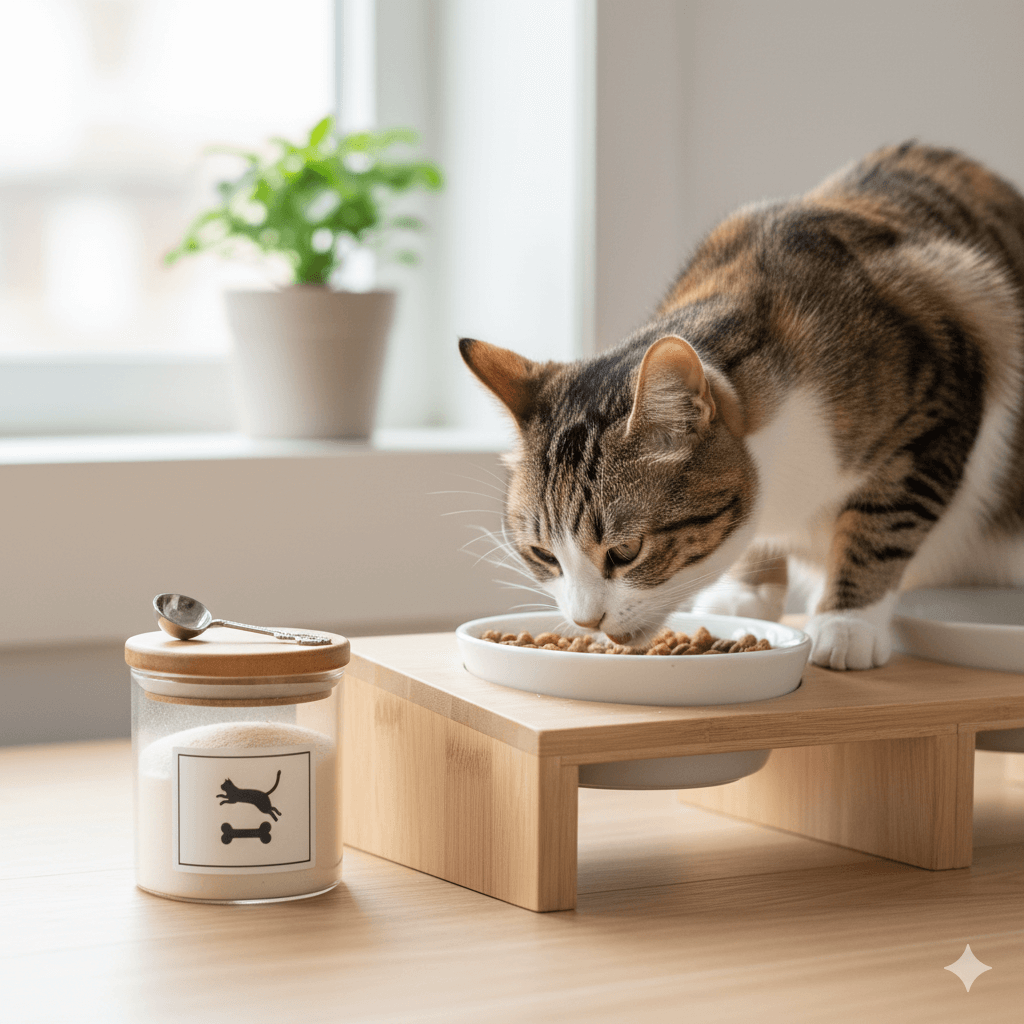Siberian Cat vs Norwegian Forest Cat: What’s the Difference?
When it comes to choosing a feline companion, the Siberian cat and the Norwegian Forest cat are two popular breeds that often top the list for their striking similarities and unique differences. Both are large, long-haired cats with a love for climbing and an affectionate nature, but they also have distinct traits that set them apart. Whether you’re drawn to the playful charm of the Siberian or the rugged elegance of the Norwegian Forest cat, understanding their characteristics is key to finding the perfect match for your lifestyle. In this blog post, we’ll compare these two magnificent breeds in detail, helping you decide which one might be the ideal addition to your home.
Key Physical Differences Between Siberian and Norwegian Forest Cats
While both breeds share a majestic appearance, there are subtle physical distinctions that make each breed unique. Understanding these differences can help you identify which cat aligns better with your preferences.
Size and Build:
Siberian cats are medium to large with a muscular, compact build, while Norwegian Forest cats are larger and more robust, with a longer body frame.Coat Texture:
Siberians have a triple-layered, water-repellent coat that feels softer and silkier to the touch. Norwegian Forest cats also have a thick triple coat but with a coarser, more rugged texture.Ear Shape and Tufts:
Siberians typically have rounded ears with minimal tufting, whereas Norwegian Forest cats boast large, triangular ears with prominent lynx-like tufts.Tail Length and Fluffiness:
Both breeds have long, bushy tails, but the Norwegian Forest cat’s tail is slightly longer and fluffier, resembling a plume.Eye Shape and Expression:
Siberians often have rounder eyes that give them a sweet, innocent expression, while Norwegian Forest cats tend to have almond-shaped eyes with a more alert look.
These physical traits highlight the beauty and individuality of each breed, making it easier to distinguish between the two.
Temperament and Personality Traits Compared
Beyond their appearance, Siberian and Norwegian Forest cats have distinct personalities that appeal to different types of cat lovers. Their temperaments play a significant role in determining compatibility with potential owners.
Affection Levels:
Siberians are known for their dog-like devotion, often following their humans around and craving attention. Norwegian Forest cats are affectionate but more independent, preferring moderate interaction.Playfulness and Energy:
Siberians are highly energetic and enjoy interactive play, including games that involve jumping and climbing. Norwegian Forest cats are playful too but tend to conserve energy for bursts of activity.Social Behavior:
Siberians are sociable and get along well with children, other pets, and strangers. Norwegian Forest cats are friendly but may take longer to warm up to new people or animals.Vocalization:
Siberians are moderately vocal, using soft chirps and trills to communicate. Norwegian Forest cats are quieter and less likely to “talk” frequently.Adaptability:
Siberians adapt quickly to new environments, making them ideal for families on the move. Norwegian Forest cats prefer stability and may need time to adjust to changes.
Understanding these personality differences ensures you choose a cat whose temperament suits your household dynamics.
Check this guide 👉Domestic Shorthair Cat vs American Shorthair: Best 7 Tips!
Check this guide 👉Bombay Cat vs Black Cat: Best 7 Expert Tips!
Check this guide 👉Flaked vs Pate Cat Food: Best 7 Expert Tips!

Siberian Cat Traits | Norwegian Forest Cat Traits |
|---|---|
Medium to large size with a stocky build | Large, sturdy build with elongated body |
Triple-layered, silky coat | Thick, coarse coat with water-resistant properties |
Highly social and affectionate | Independent yet loving |
Energetic and playful | Moderate energy with occasional bursts |
Adapts well to new environments | Prefers stable, familiar surroundings |
Grooming Needs of Siberian vs Norwegian Forest Cats
Both breeds require regular grooming due to their long, luxurious coats, but their specific needs differ slightly based on coat texture and shedding patterns.
Shedding Frequency:
Siberians shed moderately year-round, with heavier shedding during seasonal changes. Norwegian Forest cats shed heavily twice a year during spring and fall.Coat Maintenance:
Siberians’ softer coats are easier to brush and require grooming 2-3 times a week. Norwegian Forest cats’ thicker coats demand daily brushing to prevent matting.Bathing Requirements:
Siberians rarely need baths thanks to their water-repellent fur. Norwegian Forest cats may benefit from occasional baths to manage oil buildup.Undercoat Care:
Both breeds have dense undercoats, but Norwegian Forest cats’ undercoats are thicker, requiring extra attention during grooming sessions.Seasonal Considerations:
Siberians handle temperature changes well, but Norwegian Forest cats thrive in cooler climates, which can affect how their coats behave seasonally.
By understanding these grooming needs, you can keep your cat’s coat healthy and shiny while minimizing shedding around the house.
Health Considerations for Siberian and Norwegian Forest Cats
Both breeds are generally healthy, but they do have specific health concerns that potential owners should be aware of. Being informed helps ensure your cat lives a long, happy life.
Genetic Predispositions:
Siberians are prone to hypertrophic cardiomyopathy (HCM), a common heart condition in cats. Regular vet check-ups are essential.Hip Dysplasia Risk:
Norwegian Forest cats have a higher risk of hip dysplasia, a joint condition that can cause mobility issues if left untreated.Allergenic Potential:
Siberians are often marketed as hypoallergenic due to lower levels of Fel d 1 protein, though reactions vary among allergy sufferers. Norwegian Forest cats are not considered hypoallergenic.Lifespan Expectancy:
Both breeds typically live 12-16 years, but proper care and nutrition can extend their lifespan significantly.Dietary Needs:
Both breeds benefit from high-protein diets, but Norwegian Forest cats may require additional omega-3 fatty acids to support their thick coats.
Being proactive about health concerns ensures your cat remains in top condition throughout their life.
Training Tips for Siberian and Norwegian Forest Cats
Training these intelligent breeds can be a rewarding experience, provided you use positive reinforcement and patience. Here are some tips to get started.
Start Early:
Begin training kittens as soon as they settle into your home to establish routines and expectations early on.Use Treats Wisely:
Reward good behavior with small treats or praise to encourage repetition of desired actions.Teach Basic Commands:
Both breeds can learn commands like “come,” “stay,” and “no” with consistent practice.Provide Vertical Challenges:
Incorporate climbing structures and obstacle courses to channel their natural athleticism into fun activities.Be Patient and Consistent:
Training takes time, so remain patient and consistent to build trust and cooperation over time.
With dedication, you can train either breed to follow basic rules and enjoy interactive play.
Living Arrangements That Suit Each Breed
The right environment plays a crucial role in ensuring happiness for both Siberian and Norwegian Forest cats. Consider these factors when setting up your home.
Space Requirements:
Both breeds thrive in homes with plenty of vertical space, such as tall cat trees or shelves for climbing.Temperature Preferences:
Siberians adapt well to various climates, while Norwegian Forest cats prefer cooler environments reminiscent of their Scandinavian roots.Outdoor Access:
If allowed outdoors, ensure a secure enclosure to protect them from predators and traffic.Interactive Toys:
Provide stimulating toys to keep their minds engaged and prevent boredom-related behaviors.Family Dynamics:
Siberians integrate seamlessly into busy households, while Norwegian Forest cats may prefer calmer settings with predictable routines.
Creating a suitable living space enhances their quality of life and strengthens your bond.
Nutritional Needs for Optimal Health
Feeding your Siberian or Norwegian Forest cat a balanced diet is vital for maintaining their health and vitality. Keep these nutritional guidelines in mind.
High-Quality Protein Sources:
Both breeds thrive on diets rich in animal-based proteins, such as chicken, turkey, or fish.Essential Fatty Acids:
Omega-3 and omega-6 fatty acids support skin health and maintain their lustrous coats.Controlled Portions:
Monitor food intake to prevent obesity, which can lead to joint problems and other health issues.Hydration Importance:
Encourage water consumption to support kidney health, especially important for Norwegian Forest cats.Avoid Harmful Ingredients:
Steer clear of foods containing artificial additives, grains, or fillers that could upset their digestive systems.
Providing proper nutrition ensures your cat stays healthy, active, and content throughout their life.
Frequently Asked Questions About Siberian and Norwegian Forest Cats
Are Siberian cats truly hypoallergenic?
While Siberians produce fewer allergens than most cats, no cat is completely hypoallergenic. Individual reactions vary.
Do Norwegian Forest cats get along with dogs?
Yes, they generally tolerate dogs well, especially if introduced gradually and positively.
How much exercise do these breeds need?
Both breeds are active but Siberians tend to be more energetic, requiring ample playtime and stimulation.
Can these cats live in apartments?
Yes, both breeds adapt well to apartment living as long as they have vertical spaces like cat trees to climb.
Which breed is better for first-time cat owners?
Siberians are often recommended for beginners due to their adaptable and affectionate nature.
Choosing Between a Siberian Cat and a Norwegian Forest Cat
Deciding between a Siberian cat and a Norwegian Forest cat ultimately depends on your lifestyle, preferences, and ability to meet their unique needs. Both breeds offer unparalleled beauty, intelligence, and companionship, but their differences in size, temperament, and grooming requirements mean one may suit you better than the other. By carefully considering factors like energy levels, social behavior, and health considerations, you can make an informed decision that leads to a lifetime of joy with your new feline friend. Whether you choose the playful charm of a Siberian or the regal elegance of a Norwegian Forest cat, you’re sure to gain a loyal and loving companion.
Understanding Bone Supplement for Cats: Best 7 Expert Tips! – Safe, vet-approved guidance for strong feline bones & balanced nutrition.
Bone Supplement for Dogs: Best 7 Expert Tips! – Expert guide to calcium, collagen & bone health for every life stage.
Understanding Can Cats Get Sunburn: Best 7 Expert Tips! – Protect your feline from UV damage with vet-backed prevention strategies.
How to Train a Seizure Alert Dog: Best 7 Expert Tips! – Learn expert-backed steps to nurture natural instincts into reliable, life-saving seizure alerts.




